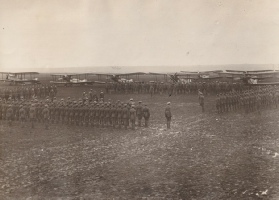After a flypast over Constantinople,  Flying Officer J.W. Jones, with his observer Aircraftman 1 B.F. Cook, broke away from the formation and carried out a reconnaissance at 2,000 feet over the Belgrade Forest area. Everything was reported as ‘normal’.
Flying Officer J.W. Jones, with his observer Aircraftman 1 B.F. Cook, broke away from the formation and carried out a reconnaissance at 2,000 feet over the Belgrade Forest area. Everything was reported as ‘normal’.
Within days, 208 Squadron had become part of Constantinople Wing RAF commanded by Group Captain P.F.M. Fellowes DSO. He was clearly happy with the manner in which the squadron had reacted to the emergency and completed its arrival within a few days of receiving orders for what at that time in the RAF’s history, was a most unusual and groundbreaking operation of rapid mobility and long-range reinforcement. By the end of the first week of October all the aircraft had been erected and the stores transferred from Constantinople to San Stefano. Reconnaissance sorties to track Kemal’s forces, their movements and their supply dumps were the priority and further formation flights were flown over Constantinople as a show of strength.
The political tension increased during the first weeks of October. Before all the RAF squadrons were in place, Lieutenant General Sir Charles Harington GBE, KCB, DSO, the Commander-in-Chief of British Forces in Turkey, had opened negotiations with Ismet Pasha, Kemal’s representative at peace talks at Mudanya but with no positive results. The Turks had surrounded Chanak by 10 October and the local British general sought permission to open fire, which was refused. Harington made one final appeal to the Turks and Pasha relented. There remained the fear that this could be a ruse and, although the immediate threat of war was reduced, the squadron began a series of regular reconnaissance flights, patrols and co-operation with the ground forces. In addition to the large number of strategic and photographic reconnaissance sorties flown, others monitored the disposition of Turkish troops and messages were dropped to the British cavalry units on patrol. With the arrival at the end of the month of other squadrons from the United Kingdom, the squadron had time to conduct bombing and wireless training flights and establish co-operation procedures with the artillery.
increased during the first weeks of October. Before all the RAF squadrons were in place, Lieutenant General Sir Charles Harington GBE, KCB, DSO, the Commander-in-Chief of British Forces in Turkey, had opened negotiations with Ismet Pasha, Kemal’s representative at peace talks at Mudanya but with no positive results. The Turks had surrounded Chanak by 10 October and the local British general sought permission to open fire, which was refused. Harington made one final appeal to the Turks and Pasha relented. There remained the fear that this could be a ruse and, although the immediate threat of war was reduced, the squadron began a series of regular reconnaissance flights, patrols and co-operation with the ground forces. In addition to the large number of strategic and photographic reconnaissance sorties flown, others monitored the disposition of Turkish troops and messages were dropped to the British cavalry units on patrol. With the arrival at the end of the month of other squadrons from the United Kingdom, the squadron had time to conduct bombing and wireless training flights and establish co-operation procedures with the artillery.
Although the immediate threat of war had receded, there was a need to maintain the large British garrison as peace talks opened in Lausanne on 20 November. The routine for 208 Squadron continued through a particularly harsh winter, which created many difficulties and discomforts for the ground crew who had limited facilities with many aircraft having to be maintained outside.



The Chanak Crisis 1922 - 02



Chanak Crisis 100th Anniversary Page 1 2 3




 Flying Officer J.W. Jones, with his observer Aircraftman 1 B.F. Cook, broke away from the formation and carried out a reconnaissance at 2,000 feet over the Belgrade Forest area. Everything was reported as ‘normal’.
Flying Officer J.W. Jones, with his observer Aircraftman 1 B.F. Cook, broke away from the formation and carried out a reconnaissance at 2,000 feet over the Belgrade Forest area. Everything was reported as ‘normal’. increased during the first weeks of October. Before all the RAF squadrons were in place, Lieutenant General Sir Charles Harington GBE, KCB, DSO, the Commander-
increased during the first weeks of October. Before all the RAF squadrons were in place, Lieutenant General Sir Charles Harington GBE, KCB, DSO, the Commander-








